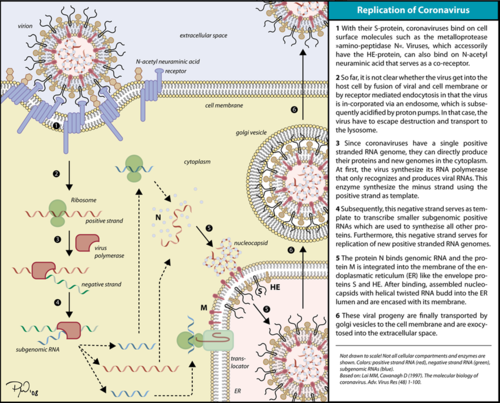User:Bruna Oliveira de Almeida/Sandbox 1
From Proteopedia
SARS-CoV-2 RNA-dependent RNA polymerase
IntroductionThe RNA dependent RNA polymerase (RdRp) of SARS-CoV-2 (also known as nsp12), which is responsible for a major outbreak of the disease called Coronavirus Disease 2019 (COVID-19), declared pandemic by WHO in 11 march 2020 [1] is an enzyme that catalyzes the synthesis of RNA of the virus SARS-CoV-2 [2](2). This virus belongs to the betacoronavirus genus[3](Zhou et al. 2020) and has a single stranded positive-sense RNA genome. Therefore, RNA dependent RNA polymerase plays a central role in the virus replication and livecycle. It’s also has been considered a good target for antiviral drugs [2](2).
FunctionThe RdRp is responsible for replication and transcription of the virus genome alongside with other non-structural proteins (NSPs). After the firsts stages of infection, follow by the translation and assembly of the replicase complex, this enzyme helps the synthesis of genomic and sub-genomic RNA. Sub-genomic RNAs are used as mRNA for structural and accessory proteins [4](4). The RdRp synthesizes negative-sense RNA and uses it as template for positive-sense strands for RNA replication for packaging into virus particles, and sub-genomic RNA transcription for translation [5](Lai and Cavanagh 1997). Moreover, it has been reported that RdRp gets complex with two other non-structural proteins NSP7 and NSP8, which act as cofactors and confer processivity to its RNA-synthesizing activity [6][7](Zhai et al. 2005, 7). StructureOverviewThe RdRp bonded to NSP7 and NSP8 consists of an approximately 160 kDa protein complex [8](8). The RNA dependent RNA polymerase of SARS-CoV-2 contains 942 amino acid residues while NSP7 has 198 and NSP8 83 residues. (To view the primary and secondary structure of SARS-CoV-2 RdRp and its cofactors visit https://www.rcsb.org/pdb/explore/remediatedSequence.do?structureId=6m71). The structure of RdRp protein of COVID-19 virus contains four domains: a “right hand” RdRp domain (residues S367-F920), a nidovirus-unique N-terminal extension domain (residues D60-R249), which has a nidovirus RdRp-associated nucleotidyltransferase domain (NiRAN) architecture, an interface domain (residues A250-R365) that connects the RdRp domain and NiRAN domain, and a newly identified β-hairpin domain at its N terminus (residues D29-K50)[2] (2). RdRp domainThe RdRp domain has a conserved architectures and comprises three subdomains: a fingers subdomain (residues L366-A581 and K621-G679), a palm subdomain (residues T582-P620 and T680-Q815), and a thumb subdomain (residues H816-E920)[2] (2). Its active site consists of the polymerase motifs A, B, C, D, E, F, and G, with important catalytic residues (759-SDD-761) been located in Motif C[2] (2). As in other viral RNA polymerases [9](9), the template-directed RNA synthesis is mediated by the RdRp domain motifs[2] (2). NiRAN and β-hairpin domainThe complete SARS-CoV-2 RdRp protein structure obtained by cryo-EM[2] [10] | ||||||||||||

